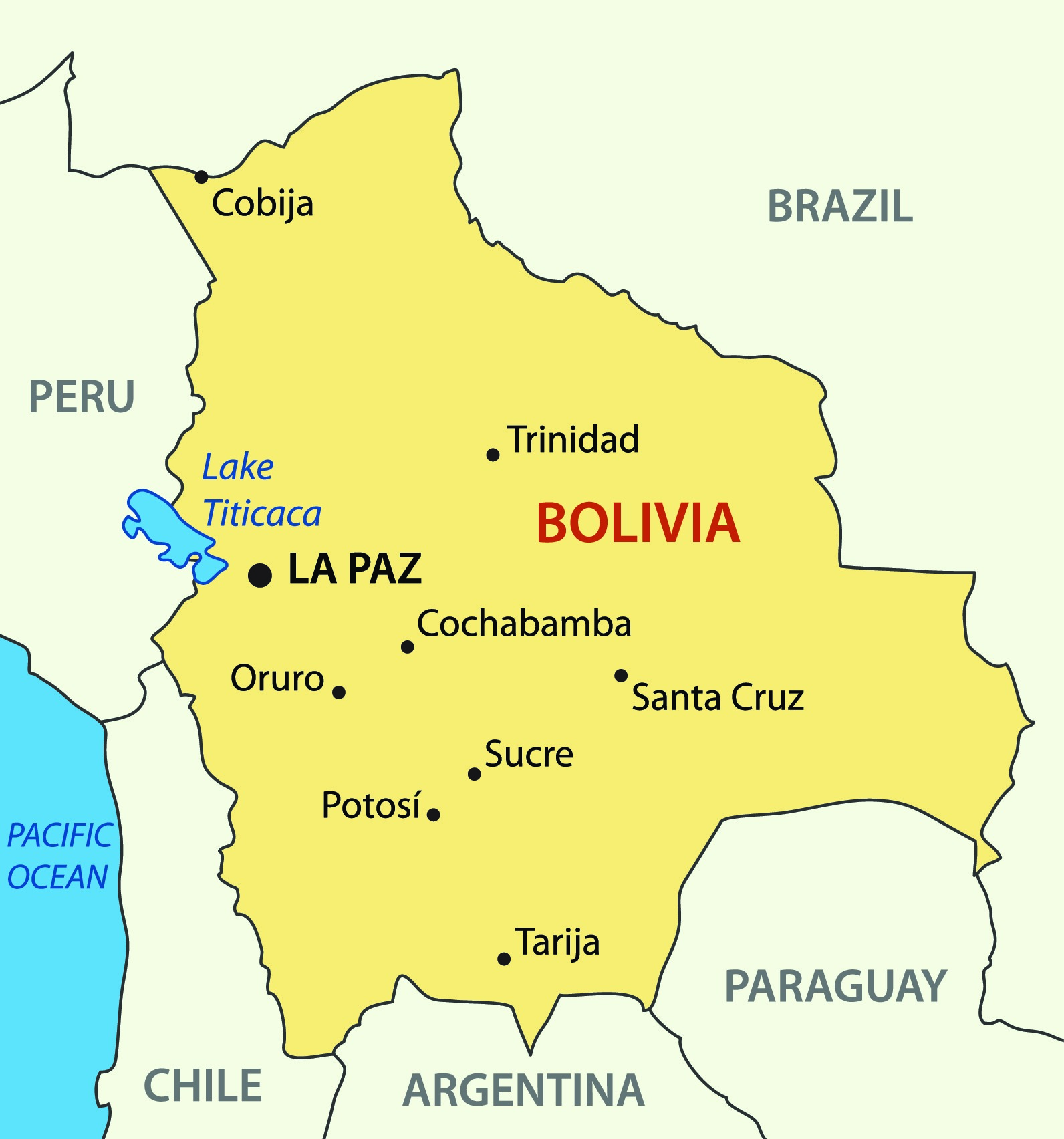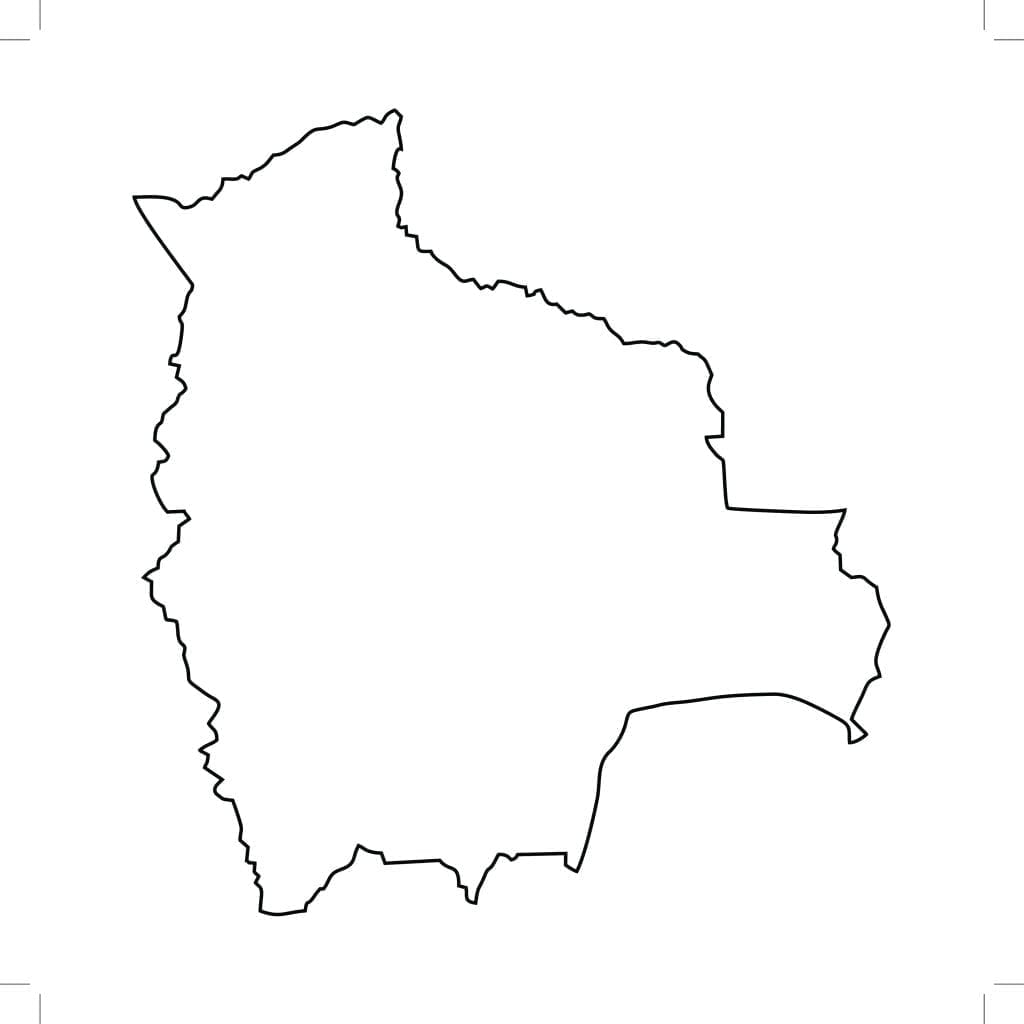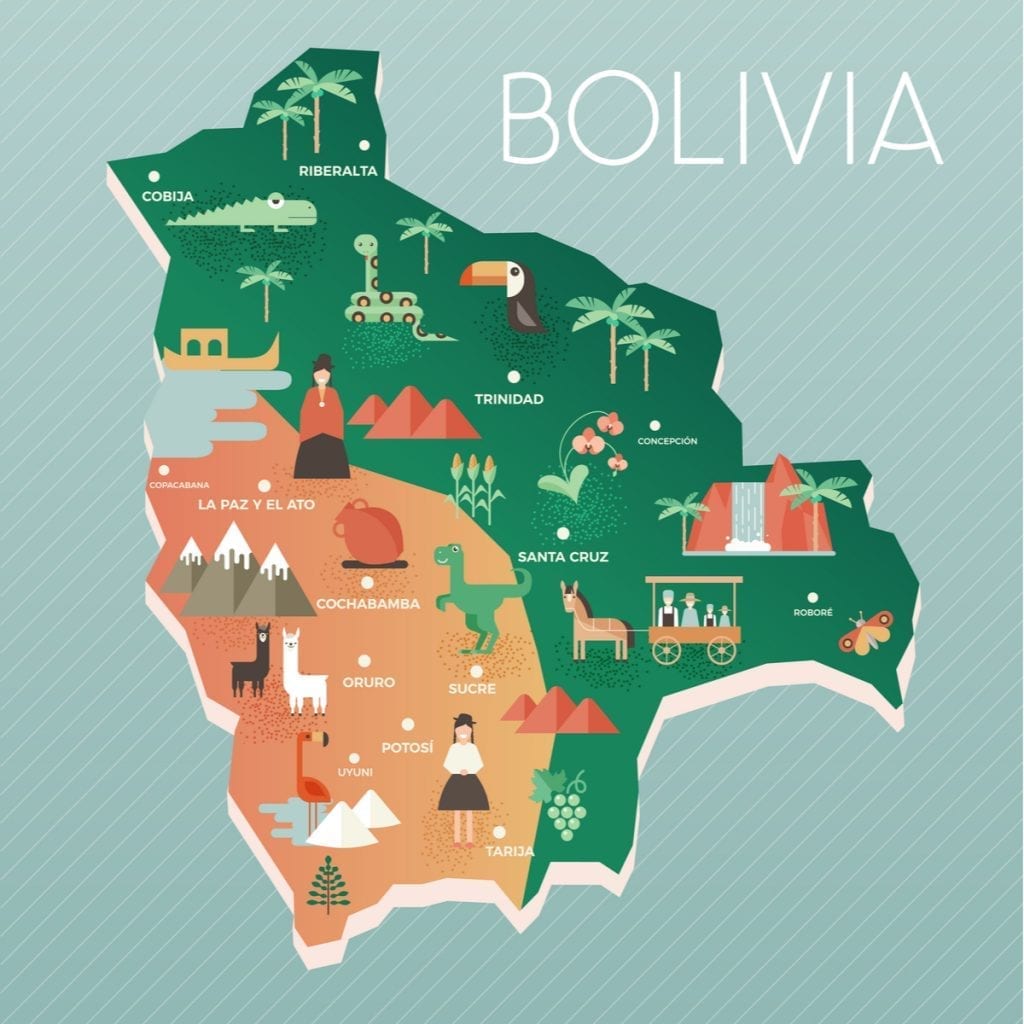
You will never find a country like Bolivia in South America. This country starts from sweltering lowlands of Amazon and ends with the cold sun-kissed mountain peaks. In short, you can enjoy all kinds of climate in this country. Let’s explore the geography of this unbelievable natural beauty.
Administrative Map of Bolivia

Political Map of Bolivia

Outline Map of Bolivia

Sunset above Bolivia from space on planet Earth with visible country borders. 3D Map of Bolivia illustration. Elements of this image furnished by NASA

Vector illustration map of Bolivia with nature, animals and people in traditional clothes

Geography of Bolivia
Bolivia is landlocked by five different countries, including Chile, Peru, Argentina, Paraguay, and Brazil. It also offers multiple incredible sights for travel lovers. Bolivia is also one of the world’s most bio-diverse countries. You will be amazed to know that it has no coast. We can divide the geography of Bolivia into two parts: the lowlands in the east and the Andean Altiplano. These two regions are completely different from each other. The western part of this country is entirely dominated by Andes mountain.
Salt Flats
When we are exploring the geography of Bolivia, we cannot miss the soaring rock formation or spectacular desert strewn. Along with that, the beauty of the largest salt flat in the world and coloured lakes attract many travellers. Not to mention, Lake Minchin, is one of the most popular places in the country evaporated near about twenty-five thousand years ago. Altiplano is also famous for numerous salt flats. These are basically ancient lakes. The largest salt flat covers over 3500 square miles and it’s called Uyuni Saltpan.
Lakes
Titicaca is one of the most popular cold lakes that sits above 3,810 metres from the sea level. This particular lake is also the world’s highest navigable water body. On the other hand, the largest and one of the most beautiful inland lakes is Lake Poopo. The size of the salty lake varies according to the rainfall.
Rivers
You will find all the significant rivers of Bolivia in the central part of this country and the north. The most important rivers are Mamore, Beni, Guapore, Desaquadero, and Madre de Dios.
La Paz
If you love climbing, you will encounter South America’s rare species like alpaca, puma, llama, vicunas, and so on. Moreover, you will come across volcanic geysers that sit 4,000 meters above sea level. Furthermore you will also encounter La Paz, which is the highest administrative capital in the world. The spectacular view of Mount Illimani is the main attraction and lies near La Paz.
Eastern Region of Bolivia
Now let’s explore the eastern part of Bolivia, which is entirely different from the western region. You can start by exploring the flora and fauna of the Amazon. Starting from giant armadillos, numerous species of monkey to piranha, catfish or dolphins everything is available in this place. If you focus on the lowlands of Santa Cruz, you will find the lush greenery and tropical cloud forest. Uniquely, the Paraque Nacional Amboro is famous for its unbelievable lash beauty.
Wetland
The largest wetland in the world is based in Bolivia called the Pantanal which is along the Eastern border of the country. You will be amazed to know that Bolivia holds 200,000 square metres of ecosystems. Everything is incorporated in this ecosystem, starting from lakes to forest, swamps, and even grasslands. The diversity of fauna impresses every nature lover as it features anacondas, different rare birds, big otters, just to name a few.
Climate of Bolivia
Bolivia offers diverse weather conditions where the type of weather depends entirely on the particular region. These two categories are the highlands and the lowlands. Temperature becomes hot and humid with lower altitude while higher altitude provides warm days and cold nights.
The highland areas
The Highland areas are La Paz, Potosi, Uyuni and Sucre. The temperature of these regions reaches the lowest in June, July and August. The Salt flats region can create a chill on your bones in this period as temperature drops below zero degrees. But this is the time when these regions are also arid. On the other hand, if you visit this region between November to March, you may encounter heavy rainfall. The temperature is generally warm during this period.
The lowland areas
The lowland regions feature Amazon, Trinidad and Santa Cruz. From September to May, you can enjoy hot and humid temperatures in these areas. Although, this is the time when you will also encounter heavy rainfall.
When is the best time to explore Bolivia?
The best time to explore Bolivia is during the wet season. It starts in September and ends in March. But keep in mind that you won’t be able to access the flooded regions of the Salt Flats. That is why some visitors prefer to explore this place in the dry season that starts from May and lasts till September. If you are an adventure seeker and love different sports like hiking, then you have to visit the Andes region between May to September.
Food and transport
If you choose to stay away from tourist areas and if you love street food, then you can buy your favourite hot dog or hamburgers by paying just US$0.80. Not to mention, you can enjoy a full meal at a restaurant for just US$1.50. This type of meal includes a combination of meat, potatoes, rice, soup and a soft drink. Bolivians usually prefer to savour more at lunchtime. Vegetables and fruits are also cheap in the local market. If you prefer Western fast foods, then you will also come across Subway and Burger King, although prices in these places will be in line with European and US prices.
Don’t worry if you don’t hire a car as you can also use public buses because it will be the cheapest and the most convenient option for tourists. However, if you are travelling long distances on buses you may struggle to sleep as the roads are bumpy and under maintained and even dangerous at times.
Bolivia Flag

Bolivia flag pattern on the fabric texture ,vintage style
Ever wondered what the Bolivian flag symbolises? Or what that strange looking rainbow flag signifies? Read on to get familiar with the history and imagery behind the country’s most notable symbol. After accomplishing independence in 1825, Bolivia’s first flag had a comparable tricolour structure yet with a green-red-green arrangement and a brilliant star and green wreath in the middle. The revolutionary legend Simon Bolivar waved the flag from the highest point of the monumental Cerro Rico in a great moment that represents the establishment of a new country on the world map.
What Bolivia’s Flag Symbolises?
The red stripe over the Bolivian flag represents the bravery of Bolivia soldiers. Yellow stands for the productive mineral assets of the country while Green symbolises the fruitfulness of the soil.
The state flag and banner has the Bolivian coat of arms on the centre yellow stripe. Another fascinating fact is that the national Bolivian flag is indistinguishable from the Ghana’s flag, aside from the fact that the flag of Ghana has a black colour star in the central point of the yellow band. There were various adaptations of the flag from 6 August 1825 until 31 October 1851 when the present national flag was authoritatively received as “THE” flag of Bolivia.
Historical Versions of Bolivia Flag
The flag of Bolivia changed a few times before the present variant was received. From 1825 to 1826, the official flag of Bolivia was a tricolour of green shaded stripes on the top as well as the base, with a red coloured stripe in the centre. Five trees encompassed by five stars were situated on the red band. From 1826 to 1851, the country received the shades of the present flag, yet they were set in an alternate order. The yellow stripe was put at the top; the red stripe was in the centre, while the green band was at the base. The country’s crest was set on the red band.
Meaning of Bolivian Flag
Bolivia has a tricolour flag, and every one of the hues holds centrality. The real imagery of the colours has been set up in the Supreme Decree of 1888. The tones are intended to symbolise the bloodshed by the saints of the country who battled to protect the republic, the natural riches, the rich natural territories and the natural assets of the country.
Facts about Bolivian Flag
- The Wiphala has attained the rank of the duel flag in Bolivia since 2009.
- Although Bolivia is surrounded by land; it has a marine pennant that is utilised on lakes and rivers.
- The moniker of Bolivia’s flag is “The Tricolor” or “La Tricolor.”
A national flag can have meaning except for the officially stated significance. An individual can consider a flag to be a representation of the opportunity that her pioneers attempted to accomplish. Another person can see that same flag as the representation of domination.
Most Popular places in Bolivia
La Paz
If you are visiting for the first time, you may find La Paz as an overcrowded city. But when you start exploring the city, your mind will change completely. The incredible setting of this city will definitely impress you. La Paz is located 3,650m above sea level. If you are a shopping buff, you will fall in love with the local markets of this place. Apart from that, you can enjoy pebble Stone Street, Witches market and great historical museums.
Salar de Uyuni
It’s time to explore the world’s largest salt flat, Salar de Uyuni. This place sits 3,500 metres above sea level. If you really want to explore this area you have to spend at least three days here. Moreover, a classic desert is based nearby 5,000 metres above sea level. At the time of sunset it creates a spectacular environment. Travellers usually visit this place to encounter water’s mirror reflection in March and April, which is quite famous in this part of the world.
Capacabana
If you are in Bolivia, you cannot miss Capacabana beach. This incredible beach town is located near the Peru border. Fish lovers don’t hesitate to try local fish as it’s delicious. First-time visitors will feel this town is a giant hill, but you can climb it quite easily. The top views of this beach town will amaze you. This is a perfect destination for all nature lovers.
Samaipata
Samaipata is just a few hours away from Santa Cruz. This is quite a beautiful city also. If you are hunting for a quiet place where you can enjoy some “alone” time, then Samaipata will be your favourite destination. This is also popular as “little Switzerland” in Bolivia for its exceptional location and breathtaking landscape. After exploring all the beautiful waterfalls in this subtropical town, you can spend some time in a coffee shop and enjoy the tranquillity around you.
Sucre
Sucre is one of the most outstanding cities in Bolivia. When you start your journey, you will find breath-taking white colonial architecture and beautiful side streets. The main square in this place is also impressive. The best part is you can take Spanish classes here at a very cheap rate.
Final Note
While exploring Bolivia, you have to keep in mind that this country, like many other countries, has various issues. You have to be aware of pick-pocketing because it is very common in Bolivia. Make sure your passport is kept in a safe place during your visit. If you pay a little attention, you can definitely enjoy Bolivia without any hassle. Banks and ATMs are always available throughout the city.
Have a wonderful stay!
BOOK ACCOMMODATION IN ANY PART OF BOLIVIA AT GREAT PRICES



